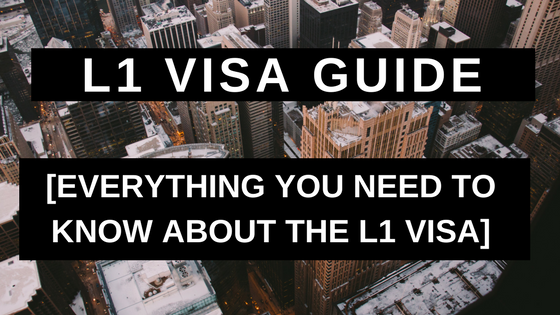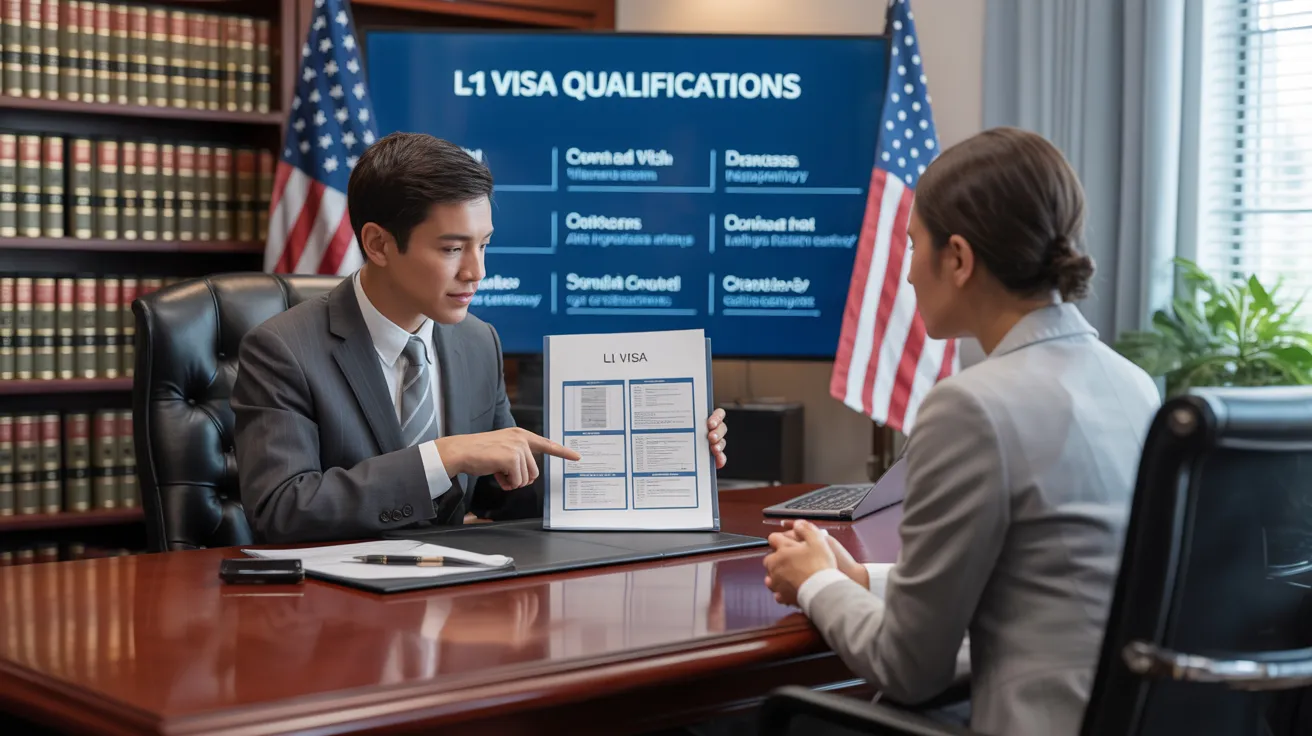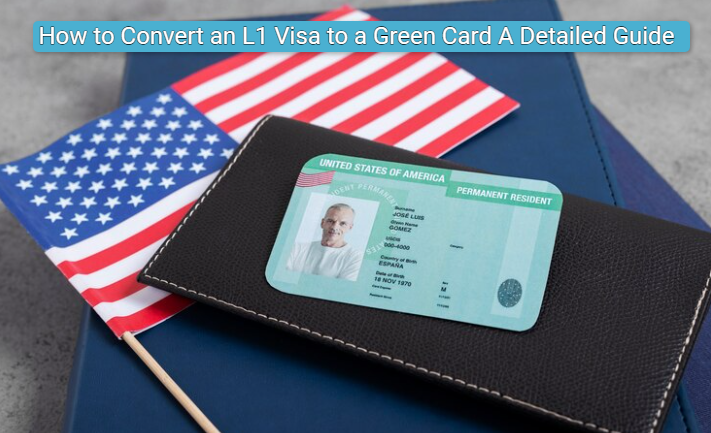Unlocking Opportunities: A Comprehensive Overview to the L1 Visa Process
The L1 visa process offers a vital pathway for international firms looking for to move vital employees across boundaries. Comprehending the subtleties of qualification criteria, the distinctions in between L-1A and L-1B visas, and the intricacies of the application procedure can significantly affect an applicant's success. Nonetheless, maneuvering this facility landscape is not without its challenges, and mindful focus to paperwork and employer sponsorship is crucial. As we discover the key elements of this procedure, the methods for getting rid of prospective barriers will become noticeable, disclosing exactly how notified prep work can open a world of chances.
Understanding the L1 Visa
Recognizing the L1 visa involves recognizing its value as a crucial device for international companies looking for to move competent employees between international offices. This non-immigrant visa group promotes the activity of executives, supervisors, and specialized knowledge employees to the USA, therefore making it possible for organizations to preserve functional continuity and harness worldwide ability successfully. The L1 visa is divided into two key classifications: L-1A for supervisors and execs, and L-1B for employees having specialized knowledge.The L1 visa serves a critical role in boosting a firm's competitive side in the global market - L1 Visa Requirements. By allowing companies to move their vital employees, services can assure that vital projects are managed by certified individuals who are currently aware of the business's society and functional processes. This internal transfer system not only cultivates knowledge sharing but also advertises technology and cooperation across borders.Moreover, the L1 visa is usually favored for its reasonably simple application procedure contrasted to other visa categories, as it enables for double intent, permitting holders to go after irreversible residency while on a short-lived job visa. This function makes the L1 visa specifically appealing for both companies and staff members, as it streamlines the path for knowledgeable specialists to develop long-lasting residency in the USA
Qualification Standards
Qualification for the L1 visa depends upon several key requirements that ensure both the employee and the company meet specific qualifications. This non-immigrant visa is made for international business to transfer workers from consular services to united state counterparts.Firstly, the employer must be a qualifying company, that includes a moms and dad business, branch, associate, or subsidiary of a united state business. The firm has to have been doing business for at least one year both in the U.S. and abroad. This ensures that the firm has enough operational stability and a legit presence.Secondly, the worker should hold a supervisory, exec, or specialized expertise placement. For L1A visas, the applicant needs to demonstrate supervisory or executive qualifications, while L1B visas concentrate on specialized understanding associated to the organization's products, services, or procedures. In addition, the employee must have helped the international entity for at the very least one continual year within the last 3 years before their application.Lastly, the worker's role in the united state must align with their previous placement, making certain that their skills and know-how are leveraged for the firm's benefit.
Kinds Of L1 Visas
The L1 visa group makes up 2 primary kinds made to help with the transfer of employees within international companies: the L1A visa for supervisors and execs, and the L1B visa for employees with specialized understanding. Each type serves distinctive objectives and has particular qualification criteria.The L1A visa is tailored for individuals that hold managerial or executive settings within a company. This visa makes it possible for high-level staff members to move to a united state branch, subsidiary, or associate of the same company. Candidates for the L1A visa have to demonstrate that they have actually been employed in a managerial or executive capacity for at the very least one continuous year within the past three years prior to their application. Furthermore, this visa offers a longer period of remain, originally approved for 3 years, with the opportunity of expansions for approximately 7 years.In contrast, the L1B visa is planned for professionals with specialized understanding relevant to the company's products, services, or processes. To certify, candidates must verify that their know-how is crucial to the organization and that they have actually functioned for a minimum of one constant year within the last 3 years in a role that needed this specialized understanding. The L1B visa is initially granted for 3 years, with extensions offered for approximately 5 years.Both visa types are crucial for firms seeking to enhance their global operations by leveraging experienced employees, therefore advertising innovation and effectiveness within the united state market.
Application Process
Guiding via the L1 copyright process involves numerous essential actions that should be carefully followed to assure a successful outcome. The process begins with the united state employer, who need to initially establish eligibility by demonstrating a certifying partnership with the foreign entity and validating that the employee fulfills the particular requirements for the L1 visa category being sought.Once qualification is confirmed, the employer starts the process by filing Form I-129, the Petition for a Nonimmigrant Worker, with the United State Citizenship and Migration Provider (USCIS) This type should be gone along with by a detailed summary of the work duties to be carried out, the business framework of both the united state and foreign entities, and the employee's certifications. It's crucial to confirm that all info is precise and full, as omissions or errors can bring about hold-ups or denials.Upon approval of the I-129 application, the following action involves the staff member looking for the L1 visa at a united state embassy or consular office in their home nation. This phase calls for the conclusion of Kind DS-160, the Online Nonimmigrant copyright, and arranging a meeting. During the interview, the applicant must provide evidence sustaining their certifications and the employer's petition.After the visa is given, the worker can enter the United States to function in the designated role. In general, cautious preparation and adherence to every step of the application process are necessary for an effective L1 visa outcome.
Called for Paperwork

Vital Types Required
Navigating the L1 Visa process requires careful interest to the vital forms and paperwork needed for a successful application. The key form needed is the Kind I-129, Petition for a Nonimmigrant Worker, which need to be finished and sent by the U.S. click here company. This form outlines the details of the work offer and the certifications of the employee looking for the L1 Visa.Alongside Form I-129, the applicant will need to total Kind I-539 if going along with household participants are likewise looking for visas. Additionally, the company should offer evidence of the qualifying partnership between the united state entity and the international entity, frequently necessitating the submission of company files such as articles of consolidation or economic statements.Moreover, it is important to consist of the L Classification Supplement to Type I-129, which defines the kind of L Visa being requested-- either L-1A for supervisors and executives or L-1B for staff members with specialized expertise. Finally, applicants should ensure that all types are authorized and dated suitably, as incomplete submissions can cause hold-ups or rejections. Correctly constructing these vital kinds lays the foundation for a smoother L1 copyright process.

Supporting Evidence Demands
Supporting paperwork is vital for an effective L1 copyright, as it validates the insurance claims made in the petition. Candidates need to give a variety of files to show eligibility for the visa, which is classified right into two key types: evidence of the certifying partnership between the U.S. and foreign entities and evidence of the applicant's qualifications.To develop the relationship, candidates ought to submit paperwork such as company business charts, financial statements, and proof of ownership. These records confirm that the international business has a qualifying partnership with the U.S. company, whether as a parent company, subsidiary, branch, or affiliate.For the candidate's certifications, essential papers include a detailed work letter from the foreign company, describing the candidate's task title, obligations, and duration of work. Furthermore, instructional credentials, such as levels and diplomas, should be supplied to verify the applicant's proficiency in the pertinent area.
Company Sponsorship Papers

Common Obstacles
Navigating the L1 visa procedure offers numerous common difficulties that candidates need to know. Key issues commonly include rigid documents demands, prospective delays in processing times, and the necessity for strict legal conformity. Comprehending these obstacles can assist applicants much better prepare and reduce risks during their copyright journey.
Documents Demands
The L1 copyright process typically provides considerable difficulties connected to documents demands. Candidates need to give considerable documents to develop qualification, which can lead to complication and prospective delays. Secret records include proof of a certifying connection in between the united state and international employer, proof of the candidate's employment background, and thorough information about the work function in the U.S.One common obstacle is gathering adequate proof to show the nature of the certifying connection. Firms commonly struggle to present clear business charts or monetary declarations that highlight the connection between the entities. Additionally, making certain that letters of assistance from employers properly mirror the candidate's job duties and qualifications is necessary, as unclear descriptions can lead to denials.Another issue occurs from the need for in-depth task summaries that straighten with the L1 visa classifications. Applicants should articulate not only their present duty yet additionally their supervisory or customized expertise responsibilities clearly. This necessitates an extensive understanding of both the applicant's placement and the governing language made use of in L1 applications.
Handling Dead Time
Experiencing hold-ups in processing times is a common difficulty encountered by L1 visa applicants, often causing frustration and unpredictability. A number of factors contribute to these hold-ups, including high application quantities, boosted scrutiny of applications, and management backlogs within the united state Citizenship and Immigration Provider (USCIS) Candidates may locate that processing times can vary substantially depending upon the service center managing their application, as each center has its own workload and efficiency degrees. Additionally, the intricacy of the applicant's instance, such as the demand for extensive documentation or explanation, can even more extend wait times.In some instances, concerns connected to the candidate's current immigration status or previous visa history may also result in additional delays, as USCIS might require more evaluation or details. It is important for prospects to stay proactive throughout this period, preserving open communication with their employers and legal reps to deal with any type of possible problems promptly.Understanding these handling time challenges can help L1 visa applicants plan for possible hold-ups and mitigate the impact on their shift and job plans. Persistence and diligence are essential virtues in navigating this detailed process.
Lawful Conformity Issues
Many L1 visa applicants experience legal conformity issues that can complicate their trip towards getting the visa. Recognizing and sticking to the details regulations established by the united state Citizenship and Immigration Solutions (USCIS) is crucial. Typical difficulties include showing the certifying connection between the foreign and U.S. companies, along with verifying that the applicant has the requisite specialized knowledge or supervisory capacity.Additionally, candidates need to give comprehensive paperwork outlining their task obligations, corporate structure, and economic stability of the united state entity. Insufficient or inaccurate paperwork can cause delays or even denials. Companies need to likewise ensure that they adhere to labor laws, consisting of wage and functioning problem standards, which can affect visa eligibility.Another usual concern includes maintaining compliance with the terms of the visa once provided. Modifications in employment status, work duties, or firm structure can necessitate changes to the visa, which if not addressed quickly can result in lawful issues. Because of this, remaining educated about conformity demands and looking for legal counsel when needed is vital to navigate the intricacies of the L1 visa procedure effectively.
Tips for Success
Success in the L1 copyright process typically rests on precise prep work and attention to information. To enhance your possibilities of approval, start by completely understanding the qualification demands for both the L1A and L1B visa groups. Assess whether your position at the business certifies as supervisory, exec, or specialized understanding, as this categorization notably affects your application.Next, gather extensive paperwork that substantiates your cases. This consists of organizational charts, thorough work summaries, and evidence of the business's operational structure. Clear and succinct evidence of the certifying partnership between the U.S. entity and the foreign entity is crucial. Verify that all files are organized practically and offered in a professional fashion, as this reflects your commitment and seriousness regarding the application.Engage the services of an experienced migration attorney that specializes in L1 visas. Their proficiency can show very useful, guiding you through complex regulations and guaranteeing that all documents abides with existing legislations. Additionally, prepare for the interview by exercising answers to typical concerns and being all set to discuss your function and payments to the business in deepness.
Often Asked Concerns
Can Family Members Members Go Along With the L1 Visa Holder?
Yes, household participants of L1 visa holders, consisting of partners and unmarried children under 21, can accompany the key visa owner. They may additionally request L2 visas, which allow them to reside in the United States.
For How Long Can I Remain on an L1 Visa?
The L1 visa enables preliminary keeps of approximately 3 years, with the opportunity of extension. L1A visa owners may remain for a maximum of seven years, while L1B visa holders can continue to be for five years.
Can L1 Visa Owners Get a Permit?
Yes, L1 visa owners can request a copyright. L1 Visa Requirements. They may pursue permanent residency through employment-based groups, commonly calling for sponsorship from their employer, provided they fulfill the required qualifications and documents demands
What Takes place if My L1 copyright Is Refuted?
If your L1 copyright is denied, you might get a notice outlining the reasons for denial. You can seek to appeal the decision, reapply, or check out alternative visa options based upon your conditions.
Exist Any Type Of Travel Limitations With an L1 Visa?
An L1 visa normally allows for international traveling; however, re-entry to the U. L1 Visa Requirements.S. rests upon keeping valid status. Vacationers ought to assure compliance with visa conditions to stay clear of difficulties upon return
Final thought
